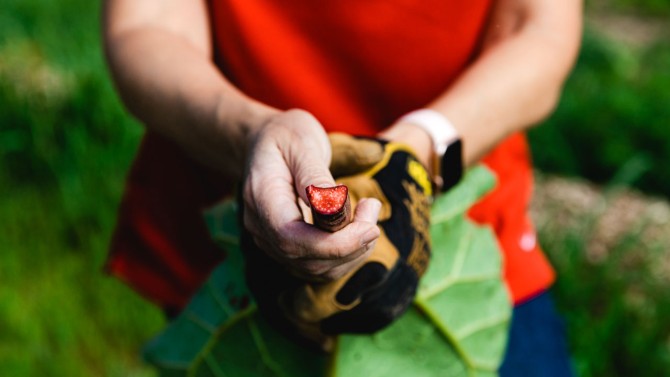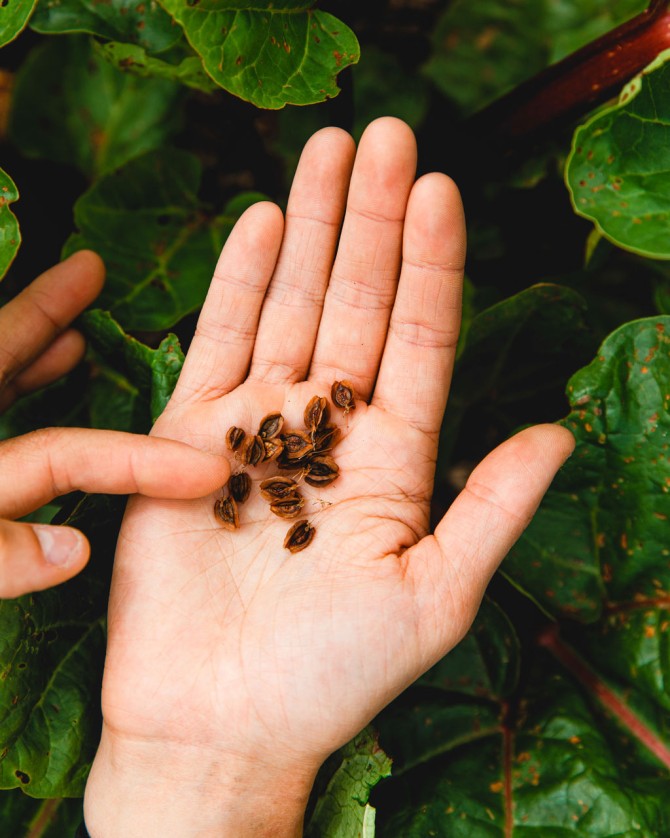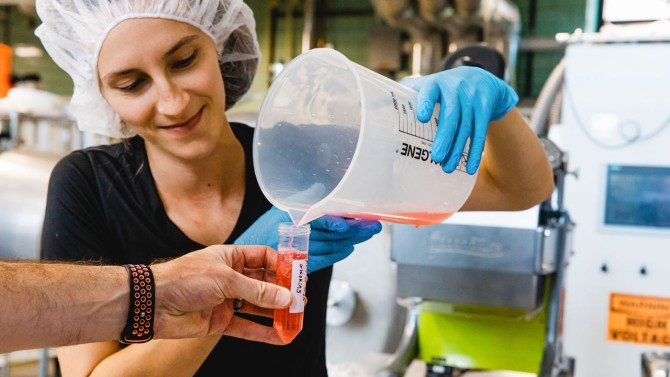
Christine Smart, Goichman Family Director of Cornell AgriTech, works in a rhubarb research field.
High stalks: Could rhubarb be New York state’s next big crop?
By Laura Reiley, Cornell Chronicle
Rhubarb is mysterious. In 1947, the USDA classified the celery-lookalike plant as a fruit because the tariffs on bringing fruits into the country were lower than on vegetables. But really, it’s a vegetable since we eat the leaf stalks, an early springtime fibrous oddity that makes its way into Passover and Easter desserts. Then, poof, it’s gone, its fleeting season over, and we move on to the bounty of summer fruits that are maybe a little easier to love.
Christine Smart, the Goichman Family Director of Cornell AgriTech and professor in the School of Integrative Plant Science (CALS), is betting these dramatic red stalks could be New York state’s next big thing. She and her team hope to develop rhubarb cultivars with many different flavors and colors, working with Chris Gerling at Cornell’s Craft Beverage Institute to trial different rhubarb varieties in craft beverages. A little sour, a little sweet, a tiny bit vegetal: It could be a significant boon to the state’s wines, beers, distilled spirits and hard ciders.
“In talking with growers, chefs and craft beverage producers, they are all looking for a crop that adds value to their products. For growers, it’s an early crop that is quite popular; for chefs it’s a great ingredient and can add a unique angle to craft beverages,” Smart said. “We are breeding rhubarb with different uses in mind.”
The project is entering its third year, and the team has over 50 unique rhubarb genotypes planted, which they ordered from the USDA germplasm repository in Pullman, Washington. Additionally, they have 100 plants each of four different cultivars – Crimson Red, Canada Red, MacDonald and Victoria – spread down 300-foot rows of raised beds. This is the first year the stalks can be harvested for use, their petioles plucked from the bottom like the outside of a celery (no relation).
Smart and her team are growing it with the goal of advancing rhubarb production in the Northeast, said Libby Indermaur, a doctoral student in Smart’s lab in the School of Integrative Plant Science Plant Pathology and Plant-Microbe Biology Section, College of Agriculture and Life Sciences.
“Our main goals are to identify cultivars or develop our own breeding lines that would be good for craft beverages, to have our own supply that is commercially viable, and to provide more information about rhubarb to growers,” she said.
In the U.S., most commercial rhubarb is grown in Washington, Oregon and Michigan; the town of Sumner, Washington claims to be the “rhubarb pie capital of the world.” Still, rhubarb enthusiasm runs higher in Western Europe, where sweet-tart treats are more the norm.
But are there growers, food producers or craft beverage makers in New York champing at the bit for more rhubarb? Smart and team think so, pointing to a large pie producer in the state that sources its rhubarb from Poland because supplies are meager closer by, and to New York craft beverage producers like Star Cider in Canandaigua, Montezuma Winery in Seneca Falls and Embark Craft Ciderworks in Williamson that have dabbled in rhubarb-inflected quaffs.
Rhubarb’s ephemeral nature excites people, says Chris Gerling, an extension associate in the Department of Food Science (CALS), but it also imparts a gorgeous color and sophisticated flavor profile to beverages.
“Rhubarb is this hiding-in-plain-sight thing. Maybe your grandmother had some, or you put it in pies, but it seems like there’s untapped potential to impart really unique flavor that adds complexity and depth to products,” Gerling said.
He said few in the Northeast have capitalized on it because there hasn’t been enough available. There are some logistical challenges to work out: One is processing, Gerling said. It’s too fibrous for traditional juicers, so harvesting the juice can be tricky.
“We talked to a winery in Minnesota that makes rhubarb wine and they were willing to tell us everything except about the machine they use to chop it,” Gerling said. Best bet: Freeze the rhubarb first, then thaw it and run it through an accordion-like benchtop juicer often used for apple cider.
And figuring out which cultivars are best for beverages is also difficult, says Colin Day, Smart’s lab manager, in part because there aren’t many trademarked cultivars and the naming of different kinds has been pretty loosey-goosey. He said a Scandinavian citizen science project revealed that people’s backyard rhubarb, even those with different names, was frequently the same cultivar.
Smart’s team tapped the USDA’s National Clonal Germplasm Repository in Pullman, Washington, which houses thousands of species of berries, tree fruits, nuts, hops and other plants, like a living seed bank for those things that are clonally propagated (rhubarb is often grown not from seed, but from separating the crown of an older plant). They have experimented with 50 cultivars – looking for best flavor, deepest color, sweetest.
“We are currently genotyping different varieties of rhubarb. I would love to have a citizen science project to genotype rhubarb from backyards across the country and see how similar they are,” Smart said. “A really interesting question is, do differences in flavor come from differences in the DNA of the rhubarb or from the soil or environment where it’s grown?”
Media Contact
Get Cornell news delivered right to your inbox.
Subscribe




